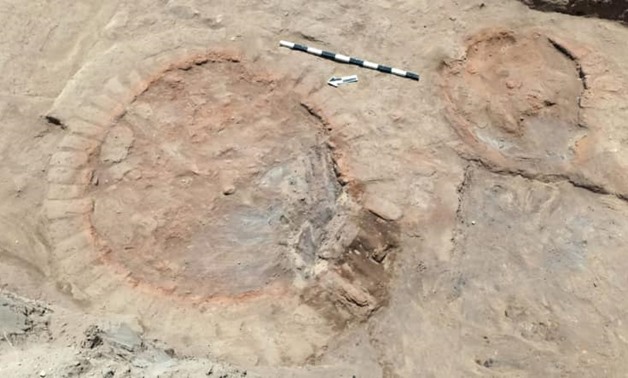https://www.egypttoday.com/Article/4/88847/Egypt-announces-discovering-burning-ovens-mud-brick-wall-dating-back
 File - Egypt announces discovering burning ovens, mud brick wall dating back to late Roman Empire.
File - Egypt announces discovering burning ovens, mud brick wall dating back to late Roman Empire. Egypt announces discovering burning ovens, mud brick wall dating back to late Roman Empire
By: Angy Essam
Mon, Jun. 22, 2020
CAIRO – 22 June 2020: CAIRO – 22 June 2020: The Egyptian mission responsible for the restoration of the Kebash road discovers a number of round ovens for burning mud bricks that bear burning marks, and a huge mud wall dating back to the late Roman Empire.
Secretary-General of the Supreme Council of Antiquities Mostafa Waziri explained that the newly uncovered ovens and wall were found in Naga'a Abu Osba in Luxor. Waziry added that these ovens might have been used to make pottery.
As for the wall, it was found western the Kebbash road of the Temple of Khonsu. It is about 30 meters in length, 2.5 meters high and 3 meters wide, and it consists of 17 courses of mud bricks.

The Egyptian mission uncovered as well a wall that was built from three horizontal rows of sandstone blocks, which is an extension of the wall that protected the eastern bank of the Nile from the changing water levels during the seasons of flood.

This wall extends from the front of the Karnak Temple in the north to the Luxor Temple in the south, along the Kebbash Road, with a length of about 3 Km.
Waziri further added that the mission members take all the necessary protective measures against the novel coronavirus, and that they all wear masks and maintain the needed social distance during the excavation work.
It is worth noting that the excavation work in various areas of Kebbash road has been ongoing since 2017 in order to unveil all the rams within the framework of the road rehabilitation project, in preparation for its opening soon.
The Pharaonic Kebbash Road is to become the longest gangway and open museum in the world.
The renovation of the Pharaonic Kebbash Road is considered a monumental moment for Luxor, as the project will bring the great road to life again.
Its new design is set to change Luxor's position on the touristic map, as it will become the longest gangway and open museum in the world.
It is expected that the new makeover of Kebbash Road will attract tourists the world over and play a vital role in pushing the Egyptian tourism forward.
Kebbash Road will be reopened after its renovation.
In Ancient Egypt, Kebbash Road connected the Karnak Temple Complex with the Luxor Temple.
During the time of the Pharaohs, the road was one of the most important, as it hosted ceremonies and festivals.
The road was opened to the public in March 2013 by the Minister of Tourism.
Although Kebbash Road is 2.7 kilometers long, a walk through it is enjoyable as there are around 1,200 statues lining one side of the road, each resembling the Sphinx (where the head is that of a ram and the body is that of a lion) and sculpted from sandstone.
This meaningful decoration is dedicated to Amun, as the head of the statues are in the form of the god's while the rest of the statue — the body of a lion — is a means of protecting the temples from looters.
-- Sent from my Linux system.
No comments:
Post a Comment